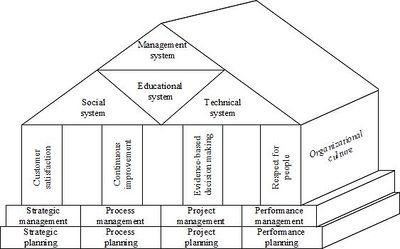House of total quality model
| House of total quality model |
|---|
| See also |
House of Total Quality Model has been developed by F. Voehl in 1992 and modified by W.M. Lindsay and J.A. Petrick in 1997. It consists of six groups of elements (T.P. Mani, N. Murugan, C. Rajendran, 2003, p. 610):
- Subsystems of the organization, such as management system, education, social and technical subsystems (roof).
- Continuous improvement of customer satisfaction, basing decisions on facts and respect for people (pillars of quality).
- Strategic management, processes, projects and tasks (base).
- Strategic planning of processes, projects and tasks (benches).
- Development of organization (mortar).
- Corporate culture (the wall).
The base of the model are the basic tasks performed in the organization. On them, four-element approach to the quality is constructed and implemented. Stable operation is provided by the appropriate management of organization which binds together the pillars. Organizational culture makes all these activities not just a façade. Thanks to it, they not only exist inside the company but also bring considerable benefits.
House of Total Quality model shows the overall approach to quality management system. Its implementation requires the operationalization of key organizational processes and introducing several different management methods and techniques. It can be a starting point for further development of detailed models for specific industries or sectors of the economy.
See also
References
- Voehl F., (1992) The house of total quality, Coral Springs, Fl: Strategy Associates, 1992
- Lindsay, W.M.; Petrick, J.A. (1997) Total Quality and Organization Development, St. Lucie Press
- Mani T. P., Murugan N., Rajendran C., (2003) Classical approach to contemporary TQM: an integrated conceptual TQM model as perceived in Tamil classical literature, Total Quality Management, 5
Author: Slawomir Wawak
